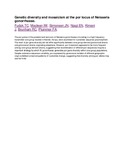| dc.description.abstract | The por genes of the predominant serovars of Neisseria gonorrhoeae circulating in a high-frequency transmitter core group located in Nairobi, Kenya, were examined for nucleotide sequence polymorphism. The level of por gene diversity did not differ significantly between core group-derived gonococcal strains and gonococcal strains originating elsewhere. However, por mosaicism appeared to be more frequent among core group-derived strains, suggesting that recombination of different por sequences may be a important strategy by which N. gonorrhoeae generates por gene diversity within core group populations. Despite extensive sequence variability, por expressed by gonococcal isolates of different geographic origin exhibited conserved patterns of nucleotide change, suggesting that diversity among por alleles may also be finite | en_US |

